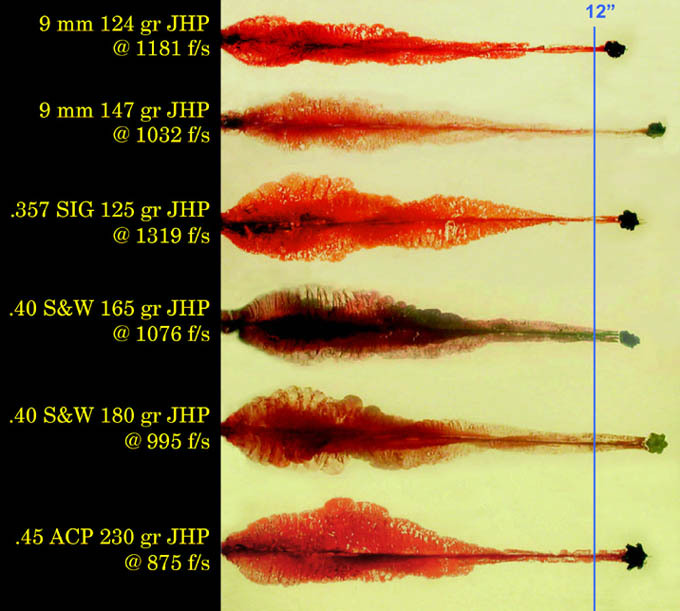Originally posted by Old Marksman
Quote:
One can find any number of cases where just about any caliber from .22 Short up to .44 Magnum incapacitated someone immediately and numerous cases where the same cartridges failed to incapacitate someone quite spectacularly.
Maybe. I can't find too many of the former, but then, I'm not looking.
Well, the well-known murder of Mark Coates would be one example, Coates shot Blackburn five times with a .357 Magnum and failed to stop him before Blackburn was able to kill Coates with a single round of .22LR (Blackburn actually fired three rounds, but two were stopped by Coates' body armor).
Another that I know the details of (a family member of mine worked in the ER when the victim was brought in) involved a man who was murdered by his roommate from roughly 25 yards away with a Raven .25 Auto. He took five rounds in the upper chest and, according to the Paramedics and Police that responded, dropped dead where he stood.
Despite these two cases and others like them, I still don't see anyone credible recommending a .22 LR or .25 Auto outside of very limited circumstances.
Quote:
If all the methods for measuring cartridge effectiveness (energy, diameter, momentum, etc.) are meaningless next to shot placement and penetration, then why is a 9mm "adequate" while everything bigger/more powerful is "overkill"? Afterall, with the right bullet selection, nearly every common handgun cartridge from .22 LR up can be made to penetrate adequately, ...?
Where did you get that idea?
Well, let's review some of what you've posted so far:
But given adequate penetration, the bullets must hit something vital, and that's where speed of fire becomes important.
Since smaller calibers than 9mm can be made to penetrate accurately, would not they be preferable since their reduced recoil allows the speed of fire to be increased? Afterall, if the measurable increase in energy, penetration, dimeter, momentum, or whatever other yardstick you'd like to use to measure terminal performance of larger calibers like .40, .45, and 10mm does not outweigh the the increased speed of fire allowed by the 9mm's reduced recoil, would not the measurable increase of those parameters of the 9mm over smaller calibers be outweighed by the smaller calibers' further increased speed of fire?
Quote:
There are two issues with that. First, it is supposedly from the FBI who is apparently trying to justify their choice to switch back to the 9mm.
"Trying to justify", or explaining the basis for a decision?
Well, to be honest, I personally suspect that there was a lot of factors outside of terminal ballistics that went into the FBI's initial move away from 9mm. I've always found it curious that they chose to focus on a single bullet fired by Agent Dove and blame it as a failure while ignoring dozens of other bullets which either hit non-vital areas or missed all together. Simply put, the manner in which the FBI went about examining the 1986 Miami-Dade shootout and their subsequent re-evaluation of handgun has jaded me on their opinions. I always got the impression that it was easier, less embarrassing, and more politically expedient to blame their guns and ammunition than their tactics and training.
Honestly, I find it somewhat humorous that after pronouncing that the 9mm was "as good as it was ever going to be" in the late 80's (at best a very short-sighted statement and at worst a thin excuse to get shiny new guns) that now, 20+ years later (and no doubt hoping that everyone had forgotten Agent Urey's innacurate statements) they're quietly going back to the very caliber that they found inadequate. Because of this, I really don't trust the objectivity of the FBI when it comes to terminal ballistics.
Quote:
Also, they specified "premium line law Auto enforcement projectiles". ... None of these premium law enforcement lines of ammo include 10mm...
Don't you think there's a reason for that?
Probably because other police departments followed the FBI like lemmings when the bureau decided that the .40 was the greatest thing since sliced bread (only a few short years after deciding that the 10mm was the greatest thing since sliced bread).
Quote:
However, you've still failed to explain why, if 9mm is better than .40 S&W due to it being "more manageable," an even smaller, lighter recoiling caliber wouldn't be better still.
I don't need to explain it. Others already have.
They did? Who explained it? Someone else in this thread? Rob Pincus? Please humor me and tell me why
you think that the 9mm is the minimum adequate caliber.
There you go again. Doesn't the statement "There is little to no noticeable difference in the wound tracks between premium line law Auto enforcement projectiles from 9mm Luger through the .45 Auto" imply that tree might be a noticeable difference in smaller rounds?
It could imply a lot of things. It could imply that there is a noticeable difference in smaller rounds, it could imply that there is a noticeable difference in larger rounds, it could imply that there is a noticeable difference in ammunition which doesn't fit into the definition of "premium line law Auto enforcement projectiles" whatever that may be. I'm not interested in implications, allusions, or hints. Please tell us all what, if any, difference there is in the wound track of a caliber smaller/less powerful than 9mm and why that difference outweighs the increased fire rate afforded by those smaller calibers' reduced recoil.

